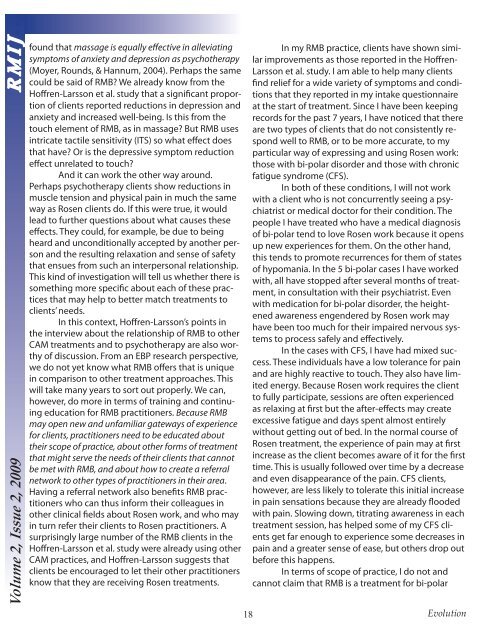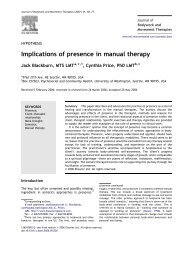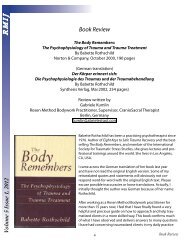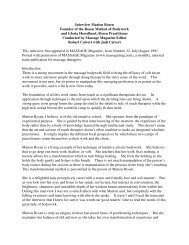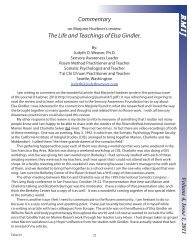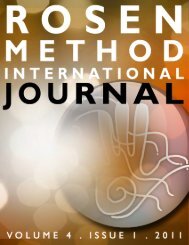RMIJ ... - Rosen Journal
RMIJ ... - Rosen Journal
RMIJ ... - Rosen Journal
You also want an ePaper? Increase the reach of your titles
YUMPU automatically turns print PDFs into web optimized ePapers that Google loves.
<strong>RMIJ</strong>...<br />
Volume 2, Issue 2, 2009<br />
found that massage is equally effective in alleviating<br />
symptoms of anxiety and depression as psychotherapy<br />
(Moyer, Rounds, & Hannum, 2004). Perhaps the same<br />
could be said of RMB? We already know from the<br />
Hoffren-Larsson et al. study that a significant proportion<br />
of clients reported reductions in depression and<br />
anxiety and increased well-being. Is this from the<br />
touch element of RMB, as in massage? But RMB uses<br />
intricate tactile sensitivity (ITS) so what effect does<br />
that have? Or is the depressive symptom reduction<br />
effect unrelated to touch?<br />
And it can work the other way around.<br />
Perhaps psychotherapy clients show reductions in<br />
muscle tension and physical pain in much the same<br />
way as <strong>Rosen</strong> clients do. If this were true, it would<br />
lead to further questions about what causes these<br />
effects. They could, for example, be due to being<br />
heard and unconditionally accepted by another person<br />
and the resulting relaxation and sense of safety<br />
that ensues from such an interpersonal relationship.<br />
This kind of investigation will tell us whether there is<br />
something more specific about each of these practices<br />
that may help to better match treatments to<br />
clients’ needs.<br />
In this context, Hoffren-Larsson’s points in<br />
the interview about the relationship of RMB to other<br />
CAM treatments and to psychotherapy are also worthy<br />
of discussion. From an EBP research perspective,<br />
we do not yet know what RMB offers that is unique<br />
in comparison to other treatment approaches. This<br />
will take many years to sort out properly. We can,<br />
however, do more in terms of training and continuing<br />
education for RMB practitioners. Because RMB<br />
may open new and unfamiliar gateways of experience<br />
for clients, practitioners need to be educated about<br />
their scope of practice, about other forms of treatment<br />
that might serve the needs of their clients that cannot<br />
be met with RMB, and about how to create a referral<br />
network to other types of practitioners in their area.<br />
Having a referral network also benefits RMB practitioners<br />
who can thus inform their colleagues in<br />
other clinical fields about <strong>Rosen</strong> work, and who may<br />
in turn refer their clients to <strong>Rosen</strong> practitioners. A<br />
surprisingly large number of the RMB clients in the<br />
Hoffren-Larsson et al. study were already using other<br />
CAM practices, and Hoffren-Larsson suggests that<br />
clients be encouraged to let their other practitioners<br />
know that they are receiving <strong>Rosen</strong> treatments.<br />
In my RMB practice, clients have shown similar<br />
improvements as those reported in the Hoffren-<br />
Larsson et al. study. I am able to help many clients<br />
find relief for a wide variety of symptoms and conditions<br />
that they reported in my intake questionnaire<br />
at the start of treatment. Since I have been keeping<br />
records for the past 7 years, I have noticed that there<br />
are two types of clients that do not consistently respond<br />
well to RMB, or to be more accurate, to my<br />
particular way of expressing and using <strong>Rosen</strong> work:<br />
those with bi-polar disorder and those with chronic<br />
fatigue syndrome (CFS).<br />
In both of these conditions, I will not work<br />
with a client who is not concurrently seeing a psychiatrist<br />
or medical doctor for their condition. The<br />
people I have treated who have a medical diagnosis<br />
of bi-polar tend to love <strong>Rosen</strong> work because it opens<br />
up new experiences for them. On the other hand,<br />
this tends to promote recurrences for them of states<br />
of hypomania. In the 5 bi-polar cases I have worked<br />
with, all have stopped after several months of treatment,<br />
in consultation with their psychiatrist. Even<br />
with medication for bi-polar disorder, the heightened<br />
awareness engendered by <strong>Rosen</strong> work may<br />
have been too much for their impaired nervous systems<br />
to process safely and effectively.<br />
In the cases with CFS, I have had mixed success.<br />
These individuals have a low tolerance for pain<br />
and are highly reactive to touch. They also have limited<br />
energy. Because <strong>Rosen</strong> work requires the client<br />
to fully participate, sessions are often experienced<br />
as relaxing at first but the after-effects may create<br />
excessive fatigue and days spent almost entirely<br />
without getting out of bed. In the normal course of<br />
<strong>Rosen</strong> treatment, the experience of pain may at first<br />
increase as the client becomes aware of it for the first<br />
time. This is usually followed over time by a decrease<br />
and even disappearance of the pain. CFS clients,<br />
however, are less likely to tolerate this initial increase<br />
in pain sensations because they are already flooded<br />
with pain. Slowing down, titrating awareness in each<br />
treatment session, has helped some of my CFS clients<br />
get far enough to experience some decreases in<br />
pain and a greater sense of ease, but others drop out<br />
before this happens.<br />
In terms of scope of practice, I do not and<br />
cannot claim that RMB is a treatment for bi-polar<br />
18 Evolution


